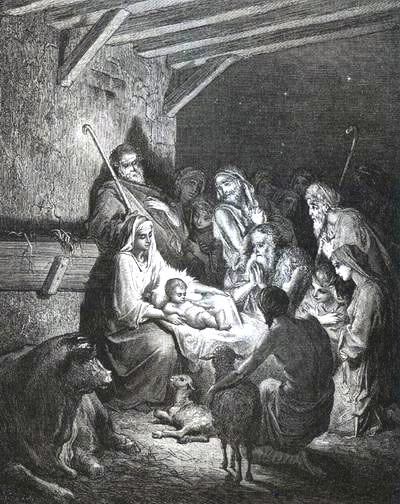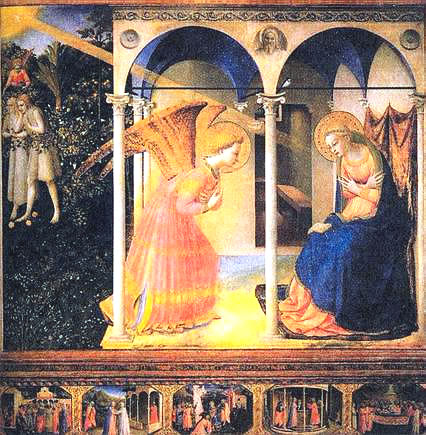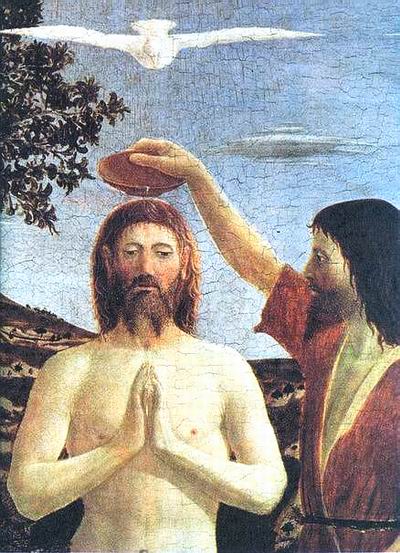The Crucifixion - Introduction -The Life of Jesus

THE NATIVITY, by Gustave Doré(1832 - 1883)
The Crucifixion
Introduction
I. — The Life of Jesus
The Crucifixion of Jesus followed by his Resurrection three days later, is the foundation upon which Christian ity exists. For this reason, the present essay focuses on the Crucifixion. But perhaps it would be useful to also have a short telling of the entire life of Jesus. All of the events of his life are to be found only in the New Testament. There is no other record.
The Annunciation, Nativity and Youth
The birth of Jesus is the story of a miracle and that miracle is called Christmas. The telling of the Christmas story is found primarily in the Gospel of Luke. A young virgin named Mary is engaged to be married to a man known as Joseph. However, as she is sitting alone, suddenly the angel Gabriel appears to her and says "Hail Mary, full of grace*-, the Lord is with you and blessed be the fruit of thy womb." At first frightened, she
______________
* grace: the divine assistance and power given to man by God.


asks how this is possible as she is a virgin. And Gabriel tells her of the miraculous conception* of the child who is to become Jesus Christ, the Saviour of mankind. And the miracle is that the Holy Spirit, another name for God, has fathered the child. That is to say, the Father of Jesus Christ is God. This scene of the Angel appearing before the startled Mary is called the Annunciation and has been a favourite subject of painters. Over Gabriel's head, one can see a dove descending in rays of golden light. This dove is God as the Holy Spirit. It is through God as the Holy Spirit that The Virgin Mary conceives Jesus in her womb. Since Mary remained a virgin despite her pregnancy, this event is known as the Immaculate** Conception.
Joseph is guided by God through dreams not to throw Mary away in disgrace, who is pregnant even though Joseph never slept with her. He being a man of great faith accepts Mary in her pregnant condition as his wife and protects her. In fact, after the birth of Jesus, he is told to run away to Egypt with her for a time because the king Herod attempted to murder all newborn boys in his kingdom because of a prediction by Three Wise men that the King of the Jews has been born. In Chapter II of Matthew, one can find the account of the Three Wisemen and how they find Jesus and Mary by following a miraculous star that guides them. They then worship the infant Jesus and present him with precious gifts. In a dream, they are told of the evil nature of Herod and that they are to leave Judea without seeing Herod again. This they do.
The birth of Jesus is the Christmas story that the world is most familiar with. For purposes of taking a census*** all citizens had to return to the city of the origin of their lineage. For
______________
* Conception: the making of a new human being by the fertilizing of the egg (ovum) by a sperm, and implantation of the fertilized egg in the womb, where it will grow until birth.
** Immaculate: morally pure; free from sin or spiritual corruption.
***census: (in ancient Rome) a registration of the population and a property evaluation for purposes of taxation For this reason, Joseph and Mary went to Bethlehem.
Joseph, this city was Bethlehem as he was of the lineage of the great king, David. As Mary and Joseph arrived in the city, her time came, but there was no room in any inn, so she had to give birth in a manger* of a barn. The description of this event in Chapter II of Luke forms the well-known scene of shepherds and farm animals surrounding the new born Saviour-to be, Jesus, that one sees everywhere in the Christian world. The Star and the Three Wise men described in Matthew are often also incorporated into scenes of the Nativity as this scene is called in paintings.
The Gospels offer very little about the growing-up of Jesus, or his life as a young man. One exception is found at the end of Chapter II of Luke, and tells of the visit of the 12-year-old Jesus to the temple in-Jerusalem where he had precocious discussions with the scholars there. We also are told that Joseph was a carpenter, and we might presume that he learned that craft, although nothing is said about that possibility in the Bible.
The Meeting with John the Baptist
John the Baptist, as he is best known, was the cousin of Jesus. His birth was six months before that of Jesus and was also miraculous, but in a different manner. His mother, Elizabeth, was very old and beyond child-bearing age when the Angel Gabriel appeared to her aged husband Zachariah and announced that they would be the parents of a blessed child who would open the way for the future Saviour. It is written that when Mary visited Elizabeth when both women were pregnant, John leaped for joy inside his mother's womb. When he was 30 years old, John began a ministry of baptism , calling all to come to him as he stood in a river and have him wash away their sins. He spoke of getting ready for the Kingdom of Heaven by cleaning oneself of sin. And he also spoke of the
__________
* manger: a box in a stable, barn, etc., from which horses or cattle feed.
coming of the man who would be the Messiah, the true Saviour. And Jesus did come to John in a river and asked to be baptised. John said that one as pure as Jesus had no need of baptism, but Jesus insisted that it was proper for all humans to receive Baptism, and so John baptised him. And when Jesus came up out of the water heaven opened and the Spirit of God descended like a dove and settled on Jesus. Then a voice came out of heaven, saying,
"This is my beloved Son, in whom I am well pleased."
And the baptism begins the ministry* of Jesus. He soon encounters certain men who intuitively are aware of his true nature and when he calls them to follow him, they immediately obey and these men become the disciples** of Jesus. By the time of the Crucifixion, there will be twelve of them. Very soon afterwards, his attends a wedding in the city of Cana. And there he has the occasion to perform his first miracle. The wine, so important for a wedding feast, runs out. Jesus asks that the many water jugs be filled with water. This water becomes wine and the feast may then continue.
Forty Days in the Desert and the Encounter with Satan
After the wedding, Jesus decides to fast*** for forty days in the desert. At the end of the forty days, Satan appears to Jesus to tempt him. If Satan were to succeed, Jesus' mission would fail. Knowing his hunger after a 40-day fast, Satan points to some stones and suggests that Jesus quickly turn them into
_____________
* ministry: various acts and deeds to promote one's religion, such as teaching.
** disciple: a personal follower of Jesus (including his 12 Apostles) during his earthly life.
*** fast: to not eat all or certain foods or meals, esp. as a religious observance.
bread and to break his fast. The answer of Jesus is famous:
"Man shall not live by bread alone, but by the Word of God."
Then Satan carried Jesus to the top of the temple in Jerusalem and advised him to jump, reassuring Jesus that God would catch him and prevent him from being hurt. To which Jesus replied,
"You shall not tempt your Lord, your God."
Finally, Satan takes Jesus to a place where he can see all the nations, and tempts Jesus once more. Satan promises that Jesus would become the ruler of all the nations if Jesus would bow to Satan an (^worship him. To this Jesus replies,
"Get away from me Satan. It is written in the Scriptures*
'You will worship the Lord, your God, and only serve Him'".
Satan had to do as Jesus commanded and left him.
Parables, Teachings and Miracles
And from this time, Jesus began his ministry in earnest. Along with his disciples, he preached and baptized always with the same message: to prepare for the Kingdom of God and to have eternal life in Heaven with God the Father. There are many examples of his teaching and of his way of teaching. Some of these are presented in this essay. For example, he used parables, short stories that emphasized his point at the moment. Or he questioned someone and by the answer made his point, which was always to prepare for the Kingdom of God. The most famous of his teachings is the Sermon on the Mount, which is discussed in this essay. During his ministry,
__________
*Scriptures: specific writings regarded as sacred by a religious group, e.g. Holy Bible.
there were the miracles: bringing the dead back to life, the healing of incurably diseased persons, feeding many people who had come to hear him with only a few fish and loaves of bread, and even walking on water during a storm.
During his ministry, his attention primarily turned toward sinners. He and his disciples were eating together with tax collectors and others who were thought to be sinners by religious people of Israel. And so these religious people demanded of Jesus why he kept such poor company and he typically answered:
"Those who are well don't need a physician, but those who are sick. I didn't come to call the righteous, but sinners to repentance." ,
And here is the key word of Jesus' message: repentance,* He asked that all be consciously aware of the acts and thoughts they have, and when one finds sin within him/herself, to stop these evil acts and thoughts and to lead a life pleasing to God. After becoming aware of your sins, you have to repent for having sinned. If true repentance took place, the Kingdom of God awaited you. If there was no repentance, you would be cast into the pit of Hell for eternity.
The Enemies of Jesus
Jesus made enemies. According to the Gospels, it was these enemies who made sure that he was eliminated by crucifixion. These enemies were the religious officials and teachers of the Jewish establishment at that time. In the Gospels they are called Scribes and Pharisees. At this point, the reader should be reminded that Judea and its capital, Jerusalem were occupied by Rome. The Hebrew people were not free to govern
______________
* repentance: the feeling of great sorrow for one's past actions or sins.
their own country. It was a policy of the Romans to allow some freedom such as religious worship and maintaining local customs. What did Jesus do to make them his enemies? First of all, he broke the Sabbath laws. The Sabbath which modern laws, Christians and Moslems still follow has the same foundation as that of the Hebrews from the time of Moses. Keepins the Sabbath is the fourth of the Ten Commandments. After the Creation, which lasted six days. God said that He would rest and that the seventh day of the week was to always be a day of rest.
12 Observe the Sabbath day and keep it holy, as the Lord your God commanded you. 13 Six days you shall labor and do all your work. 14 But the seventh day is a Sabbath to the Lord your God; you shall not do any work ? you, or your son or your daughter, or your male or female slave, or your ox or your donkey, or any of your livestock, or the resident alien in your towns, so that your male and female slave may rest as well as you. 15 Remember that you were a slave in the land of Egypt, and the Lord your God brought you out from there with a mighty hand and an outstretched arm; therefore the Lord your God commanded you to keep the Sabbath day.
(Deut 5: 12-15)
As the Jewish religion developed, what was meant by 'rest' had to be defined. So many rules and regulations were created over the years as to what could and could not be done on the Sabbath. And these rules exist even today among religious Jewish, Moslem and Christian people. However, Jesus said that mercy and compassion were more important than rules and regulations. Once when he cured a man's withered hand in the synagogue*- on the Sabbath, the Pharisees were furious and "egan to plot to kill him. But Jesus insisted "The Sabbath was made for man, not man for the Sabbath."
________
*synagogue: the place of worship and gathering of a Jewish congregation.
Forgiving Sin by the Son of Man
But perhaps the most provoking acts and words of Jesus were those by which he acted as if he possessed the authority of God. That is to say, he virtually declared himself to be God. In the Gospels, Jesus forgives sins. How can a man forgive sin? Only God can forgive sins. There are several such incidents in the Gospels. When the Pharisees witnessed the curing of a paralyzed man after Jesus said to him
"Your sins are forgiven."
they angrily exclaimed, "Who is this that speaks blasphemies*? Who can forgive sins but God alone! And then Jesus said,
"I said it in order that you may know that, the Son of man has authority upon earth to forgive sins."
As the punishment for a blasphemer was to be put to death, the officials of the temple plotted his death. After the Last Supper, Jesus was betrayed by a traitorous disciple called Judas Iscariot. This is a famous scene which takes place in the Garden of Gethsemane. Judas led a group of Roman soldiers. He went to Jesus and kissed him. This display of perverse love was the signal to the soldiers that here was Jesus. And so he was arrested and led to the High Priest of the temple where he was found guilty of blasphemy31'. He was then led to the head of the Roman occupation, Pontius Pilate, who found it difficult to condemn Jesus to death, so Pilate, in another famous scene, washed his hands of the responsibility of sentencing Jesus to death. It was the custom that at the time of the Passover, one man could be freed and thus saved from crucifixion (see Note). Pilate then asked the crowd of Jews who do they wish to be saved, and the crowd condemned Jesus to death by ;
__________
* blasphemy: an act or words which insult God or a holy place,
shouting the name of a criminal, Barabbas to be freed. Since the execution of a non-Roman meant crucifixion, this was his sentence. First, however, Jesus was scourged or whipped and then was made to carry the horizontal part of the cross along the Via Dolorosa as the traditional path he trod to the site of the Crucifixion is called.
That Jesus is God and died on the Cross to allow sinners to be saved is one of the most basic dogmas of the Christian religion. And thus Jesus becomes Jesus Christ. This is officially stated in the Nicene Creed, which is presented in this essay. By allowing Himself (God/Jesus) to be sacrificed on the Cross, He showed His love for humanity, because humans were doomed to sin by their nature and therefore, to be damned to Hell. By the sacrifice of God Himself, who was also Jesus the human, on the Cross, the sins of humanity could be forgiven. There were three conditions: First, all humans must be baptized which will wash away the Original Sin of Adam and Eve. Secondly, every human must lead as sinless a life as possible, repenting whenever there is a falling back to sin. And finally, each human must have complete faith in the miracle of the Crucifixion and Resurrection, whereby God/Jesus redeemed humanity from The Fall of Adam and allowed humanity the opportunity to be saved so that a soul could be with God in Heaven for eternity having been forgiven the sins that each would commit during a lifetime. After His Resurrection, Jesus says
[Mark 16:15] And he said to them, "Go into all the world and-preach the gospel to the whole creation.
[Mark 16:16] He who believes and is baptized will be saved; but he who does not believe will be condemned."
*
Related Books
- Alexander the Great
- Arguments for The Existence of God
- But it is done
- Catherine The Great
- Danton
- Episodes from Raghuvamsham of Kalidasa
- Gods and The World
- Homer and The Iliad - Sri Aurobindo and Ilion
- Indian Institute of Teacher Education
- Joan of Arc
- Lenin
- Leonardo Da Vinci
- Lincoln Idealist and Pragmatist
- Marie Sklodowska Curie
- Mystery and Excellence on The Human Body
- Nachiketas
- Nala and Damayanti
- Napoleon
- Parvati's Tapasya
- Science and Spirituality
- Socrates
- Sri Krishna in Brindavan
- Sri Rama
- Svapnavasavadattam
- Taittiriya Upanishad
- The Aim of Life
- The Crucifixion
- The Good Teacher and The Good Pupil
- The Power of Love
- The Siege of Troy
- Uniting Men - Jean Monnet